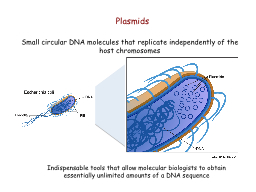

S mall circular DNA molecules that replicate independently of the host chromosomes How are plasmids constructed What functional elements are found in our yeast overexpression plasmids How are plasmids purified ID: 1011819
Download Presentation The PPT/PDF document "Plasmids Indispensable tools that allow ..." is the property of its rightful owner. Permission is granted to download and print the materials on this web site for personal, non-commercial use only, and to display it on your personal computer provided you do not modify the materials and that you retain all copyright notices contained in the materials. By downloading content from our website, you accept the terms of this agreement.
1. PlasmidsIndispensable tools that allow molecular biologists to obtain essentially unlimited amounts of a DNA sequenceSmall circular DNA molecules that replicate independently of the host chromosomes
2. How are plasmids constructed?What functional elements are found in our yeast overexpression plasmids?How are plasmids purified?
3. Plasmids used in molecular biology have been constructed in the labMolecular cloningEnzymes are used to insert desired pieces of foreign DNA into plasmidsBacterial cells are transformed with the plasmids. Copies of the plasmids are purified from bacteria.
4. Shuttle vectors have origins of replication and selectable markers for propagation in both bacteria and yeastWe are using plasmids that have been termed shuttle vectors, because they can be propagated in either bacteria or yeastPlasmids are propagated in bacteria, which grow quickly and maintain multiple copies of the plasmidsnon-pathogenic strain of Escherichia coliSaccharomyces cerevisiae deletion strainsPlasmid-encoded genes are expressed in yeast, and phenotypes are analyzed
5. How are plasmids constructed?What functional elements are found in our yeast overexpression plasmids?How are plasmids purified?
6. 1URA3 2β-lactamase gene3pBR322 ori4yeast 2 µm origin5GAL1 promoter6C-terminal tags123456ORF goes here*Plasmid names begin with a lower case “p”The pBG1805*-derived plasmids are complex vectors designed to express S. cerevisiae ORFs
7. pYES2.1-based plasmids used for S. pombe ORFs have many elements in common with pBG1805-based plasmidspYES2.1 (5886 bp)used for S. pombe ORFs123457213456URA3 β-lactamase genepBR322 oriyeast 2 µm originGAL1 promoterC-terminal tags7pBG1805 (6573 bp)used for S. cerevisiae ORFs123456ORF goes hereORF goes here
8. How are plasmids constructed?What functional elements are found in our yeast overexpression plasmids?How are plasmids purified?
9. Plasmids are much smaller than bacterial chromosomesPlasmids are supercoiled in their native formSupercoiling allows plasmids to renature quickly after they are denaturedPlasmid purification is based on their distinctive physical propertiesPlasmids used in molecular biology are highly engineered and contain elements of use to researchers
10. Plasmid purification from bacteria relies on their unique physical propertiesBacterial cell with plasmidscontainscontainscontainsMANY different, well-folded proteins1-2 copies of large (>Mbp) , circular bacterial DNA complexed with proteinsMultiple copies of small (5-15 kbp) plasmidsPurification involves sequential denaturation and renaturation steps
11. Cells are first treated with base and a detergentbreaks open membrane and denatures both DNA and proteinsProteins denature irreversiblyChromosomal DNA denatures—will have difficulty renaturing because of its length and many proteins complexed to itPlasmids denature, but strands stay together because of supercoiling
12. Extract is neutralized to allow DNA molecules to renaturePlasmids renature and are suspended in the SUPERNATANTfollowing centrifugationProteins and chromosomal DNA form aggregate irreversibly, forming a PRECIPITATE that can be collected by centrifugationWhen purifying plasmids, use a micropipette to remove the supernatant for further processing steps
13. Zyppy purification kit use multiple steps to purify plasmidsAlkaline lysisNeutralizationPurification of plasmid DNA on a silica resinElution of purified DNA from he silica resinLet's look at the individual steps……………..
14. 1 Transformed E. coli cultures are concentrated by centrifugation2. The cell pellet is resuspended in 600 µL TE buffer by vortexing3. 100 µL of 7X Blue Zyppy lysis buffer is added0.1 N NaOH in buffer lyses the cellsGENTLY mix the contents by inverting the tube 4-6 timesSolution changes from cloudy to clear when cells are lysedWarning: too much mechanical agitation can shear chromosomal DNAAlkaline lysis
15. Neutralization4. Add 350 µL yellow Zyppy Neutralization bufferMix by inverting several timesA heavy precipitate will begin to form immediately! The initial “glop” will become more granular when neutralization is complete—but don’t overdo it!The precipitate contains denatured proteins and the denatured chromosomal DNA.5. Spin down the denatured molecules for 3 minutes at top speed. CAREFULLY remove the supernatant containing the plasmid – Don't be greedy! Purity is preferred to yield!
16. Purification on Zyppy silica resin6. Apply the supernatant to the spin column. Place the column in the collection tube. Centrifuge the column for ~15 seconds at top speed.7. Discard the flow through in the collection tube. Add 200 µL Zyppy EndoWash. Centrifuge ~15 sec.EndoWash contains guanidine hydrochloride and isopropanol. It removes contaminating proteins that are bound to the resin.8. Discard the flow through in the collection tube. Add 400 µL Column Wash. Centrifuge 1 min.
17. Plasmid Elution9. Transfer the column to a clean, LABELED microcentrifuge tube10. Add 50 µL TE buffer directly on top of the column. Allow the column to stand upright in the test tube for ~10 min. (Plasmid is being eluted.) 11. Spin the column for 30 seconds. Plasmid DNA will be collected in the microcentrifuge tube.Pure plasmid DNA collects here!